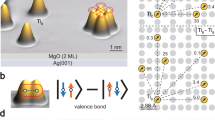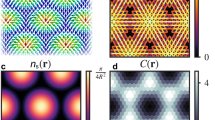Abstract
Artificial quantum systems have emerged as platforms to realize topological matter in a well-controlled manner. So far, experiments have mostly explored non-interacting topological states, and the realization of many-body topological phases in solid-state platforms with atomic resolution has remained challenging. Here we construct topological quantum Heisenberg spin lattices by assembling spin chains and two-dimensional spin arrays from spin-1/2 Ti atoms on an insulating MgO film in a scanning tunnelling microscope. We engineer both topological and trivial phases of the quantum spin model and thereby realize first- and second-order topological quantum magnets. We probe the many-body excitations of the quantum magnets by single-atom electron spin resonance with an energy resolution better than 100 neV. Making use of the atomically localized magnetic field of the scanning tunnelling microscope tip, we visualize various many-body topological bound modes including topological edge states, topological defects and higher-order corner modes. Our results provide a bottom-up approach for the simulation of exotic quantum many-body phases of interacting spins.





Similar content being viewed by others
Data availability
The data that support the plots within this paper are available via the Figshare repository at https://doi.org/10.6084/m9.figshare.26379964. Additional data are available from the authors upon request.
References
Narang, P., Garcia, C. A. C. & Felser, C. The topology of electronic band structures. Nat. Mater. 20, 293–300 (2021).
Tokura, Y., Yasuda, K. & Tsukazaki, A. Magnetic topological insulators. Nat. Rev. Phys. 1, 126–143 (2019).
Kiczynski, M. et al. Engineering topological states in atom-based semiconductor quantum dots. Nature 606, 694–699 (2022).
de Léséleuc, S. et al. Observation of a symmetry-protected topological phase of interacting bosons with Rydberg atoms. Science 365, 775–780 (2019).
Sompet, P. et al. Realizing the symmetry-protected Haldane phase in Fermi–Hubbard ladders. Nature 606, 484–488 (2022).
Drost, R., Ojanen, T., Harju, A. & Liljeroth, P. Topological states in engineered atomic lattices. Nat. Phys. 13, 668–671 (2017).
Mishra, S. et al. Observation of fractional edge excitations in nanographene spin chains. Nature 598, 287–292 (2021).
Kempkes, S. N. et al. Robust zero-energy modes in an electronic higher-order topological insulator. Nat. Mater. 18, 1292–1297 (2019).
Meier, E. J., An, F. A. & Gadway, B. Observation of the topological soliton state in the Su–Schrieffer–Heeger model. Nat. Commun. 7, 13986 (2016).
St-Jean, P. et al. Lasing in topological edge states of a one-dimensional lattice. Nat. Photon. 11, 651–656 (2017).
Rizzo, D. J. et al. Topological band engineering of graphene nanoribbons. Nature 560, 204–208 (2018).
Gröning, O. et al. Engineering of robust topological quantum phases in graphene nanoribbons. Nature 560, 209–213 (2018).
Schneider, L. et al. Topological Shiba bands in artificial spin chains on superconductors. Nat. Phys. 17, 943–948 (2021).
Khajetoorians, A. A., Wegner, D., Otte, A. F. & Swart, I. Creating designer quantum states of matter atom-by-atom. Nat. Rev. Phys. 1, 703–715 (2019).
Choi, D.-J. et al. Colloquium: atomic spin chains on surfaces. Rev. Mod. Phys. 91, 041001 (2019).
Nadj-Perge, S. et al. Observation of Majorana fermions in ferromagnetic atomic chains on a superconductor. Science 346, 602–607 (2014).
Liebhaber, E. et al. Quantum spins and hybridization in artificially-constructed chains of magnetic adatoms on a superconductor. Nat. Commun. 13, 2160 (2022).
Soldini, M. O. et al. Two-dimensional Shiba lattices as a possible platform for crystalline topological superconductivity. Nat. Phys. 19, 1848–1854 (2023).
Yang, K. et al. Probing resonating valence bond states in artificial quantum magnets. Nat. Commun. 12, 993 (2021).
Zhao, Y. et al. Quantum nanomagnets in on-surface metal-free porphyrin chains. Nat. Chem. 15, 53–60 (2023).
Zhao, C. et al. Tunable topological phases in nanographene-based spin-1/2 alternating-exchange Heisenberg chains. Preprint at https://arxiv.org/abs/2402.13590v1 (2024).
Yang, K. et al. Engineering the eigenstates of coupled spin-1/2 atoms on a surface. Phys. Rev. Lett. 119, 227206 (2017).
Bae, Y. et al. Enhanced quantum coherence in exchange coupled spins via singlet–triplet transitions. Sci. Adv. 4, eaau4159 (2018).
Hida, K. Crossover between the Haldane-gap phase and the dimer phase in the spin-1/2 alternating Heisenberg chain. Phys. Rev. B 45, 2207–2212 (1992).
Yang, K. et al. Tuning the exchange bias on a single atom from 1 mT to 10 T. Phys. Rev. Lett. 122, 227203 (2019).
Haghshenas, R., Langari, A. & Rezakhani, A. T. Symmetry fractionalization: symmetry-protected topological phases of the bond-alternating spin-1/2 Heisenberg chain. J. Phys. Condens. Matter 26, 456001 (2014).
Luo, Q., Zhao, J., Wang, X. & Kee, H.-Y. Unveiling the phase diagram of a bond-alternating spin-1/2 K–Γ chain. Phys. Rev. B 103, 144423 (2021).
Lado, J. L., Ortiz, R. & Fernández-Rossier, J. in Graphene Nanoribbons (eds. Brey, L., Seneor, P. & Tejeda, A.) Ch. 4 (IOP Publishing, 2019).
Willke, P. et al. Magnetic resonance imaging of single atoms on a surface. Nat. Phys. 15, 1005–1010 (2019).
Benalcazar, W. A., Bernevig, B. A. & Hughes, T. L. Electric multipole moments, topological multipole moment pumping, and chiral hinge states in crystalline insulators. Phys. Rev. B 96, 245115 (2017).
Willke, P. et al. Probing quantum coherence in single-atom electron spin resonance. Sci. Adv. 4, eaaq1543 (2018).
Hatsugai, Y. Quantized Berry phases for a local characterization of spin liquids in frustrated spin systems. J. Phys. Condens. Matter 19, 145209 (2007).
Pollmann, F., Turner, A. M., Berg, E. & Oshikawa, M. Entanglement spectrum of a topological phase in one dimension. Phys. Rev. B 81, 064439 (2010).
Noh, J. et al. Topological protection of photonic mid-gap defect modes. Nat. Photon. 12, 408–415 (2018).
Schindler, F. et al. Higher-order topology in bismuth. Nat. Phys. 14, 918–924 (2018).
Yang, K. et al. Coherent spin manipulation of individual atoms on a surface. Science 366, 509–512 (2019).
Wang, Y. et al. An atomic-scale multi-qubit platform. Science 382, 87–92 (2023).
Broholm, C. et al. Quantum spin liquids. Science 367, eaay0668 (2020).
Baumann, S. et al. Electron paramagnetic resonance of individual atoms on a surface. Science 350, 417–420 (2015).
Acknowledgements
This work is supported by the National Key R&D Program of China (2022YFA1204100 (K.Y. and L.J.)), the Beijing Natural Science Foundation (Z230005 (K.Y., and P.F.)), the National Natural Science Foundation of China (12174433 (K.Y.), 52272170 (L.J.) and 62488201 (H.-J.G.)), and the CAS Project for Young Scientists in Basic Research (YSBR-003 (K.Y.)). J.L.L. acknowledges the computational resources provided by the Aalto Science-IT project, the financial support from the Academy of Finland Projects (nos. 331342 and 358088) and the Jane and Aatos Erkko Foundation.
Author information
Authors and Affiliations
Contributions
K.Y. and J.L.L. designed the experiment. H.W., P.F., J.C., L.J. and K.Y. carried out the STM measurements. J.L.L. developed the theoretical model. H.W., L.J., H.-J.G., K.Y. and J.L.L. performed the analysis and wrote the manuscript with help from all authors. All authors discussed the results and edited the manuscript.
Corresponding authors
Ethics declarations
Competing interests
The authors declare no competing interests.
Peer review
Peer review information
Nature Nanotechnology thanks Dario Bercioux, Rémy Pawlak and the other, anonymous, reviewer for their contribution to the peer review of this work.
Additional information
Publisher’s note Springer Nature remains neutral with regard to jurisdictional claims in published maps and institutional affiliations.
Extended data
Extended Data Fig. 1 Magnetic resonance imaging (MRI) of the dimerized 6-spin chain.
(a) STM image (1.3 nm × 5.6 nm) and binding sites for the dimerized 6-spin chain with topological configuration. Scale bar: 5 Å. (b) MRI of the chain showing spatially resolved spin resonance signal for a fixed frequency at f = 15.86, 17.18, 16.32 and 16.45 GHz, respectively (VDC = 50 mV, I = 50 pA, VRF = 16 mV, \({B}_{{\rm{ext}}}\) = 0.68 T).
Extended Data Fig. 2 Quantum coherence T2 of the end modes of a dimerized 6-spin chain and isolated Ti spins.
T2 was obtained by measuring the linewidth of the ESR peak at different VRF (VDC = 50 mV, I = 5–40 pA, VRF = 6–55 mV, \({B}_{{\rm{ext}}}\) = 0.68 T). Error bars are from the fitting uncertainties of T2 with a 95% confidence.
Extended Data Fig. 3 An 8-spin chain with topologically trivial configuration.
(a) STM image (1.5 nm × 7 nm) and binding sites of a dimerized 8-spin chain on MgO. Scale bar: 5 Å. (b) ESR spectra measured on each of the 8 spins as a function of setpoint current I, which is approximately proportional to \({B}_{{\rm{tip}}}\) (VDC = 50 mV, I = 20–220 pA, VRF = 4–25 mV, \({B}_{{\rm{ext}}}\) = 0.59 T). (c) ESR spectra measured along the dashed line in a (VDC = 50 mV, I = 60 pA, VRF = 20 mV). (d) Calculated average magnetization \(\left\langle {S}_{n}^{z}\right\rangle\) for its ground state \(\left|1\right\rangle\) and two excited states \(\left|2\right\rangle\) and \(\left|3\right\rangle\). (e) ESR spectra measured on a single Ti spin (VDC = 50 mV, I = 10–240 pA, VRF = 4–25 mV).
Extended Data Fig. 4 Dimerized 6-spin chains without and with the second-nearest-neighbor coupling.
STM images and ESR spectra of dimerized 6-spin chains without (a–c) and with (d–f) second-nearest-neighbor coupling (~1 GHz). Scale bars in (a, d): 5 Å. For the spin chain in (d), the second-nearest-neighbor coupling is between S1 and S3 as well as between S4 and S6. (b, e) ESR spectra measured on spins S1, S2 and S3 as a function of setpoint current I, which is approximately proportional to \({B}_{{\rm{tip}}}\) (VDC = 50 mV, I = 10–142 pA, VRF = 2.5–10 mV, \({B}_{{\rm{ext}}}\) = 0.68 T). (c, f) Zoom-in ESR spectra showing the singlet-triplet splitting (VDC = 50 mV, I = 10 pA, VRF = 10-20 mV).
Extended Data Fig. 5 ESR spectra of S1 to S4 and S6 to S9 of the 9-spin chain.
(a) STM image (1.75 nm × 8.3 nm) and binding sites of the dimerized 9-spin chain on MgO with a topological defect in the middle. Scale bar: 5 Å. (b) ESR spectra measured on each of the 8 spins as a function of setpoint current I, which is approximately proportional to \({B}_{{\rm{tip}}}\) (VDC = 50 mV, I = 20–155 pA, VRF = 6–30 mV, \({B}_{{\rm{ext}}}\) = 0.68 T).
Extended Data Fig. 6 ESR spectra of all the spins of the dimerized 4×4 spin lattice.
(a) STM image (4 nm × 4 nm) of the 4×4 spin lattice. Scale bar: 5 Å. (b) ESR spectra measured on each of the 16 spins as a function of setpoint current I, which is approximately proportional to \({B}_{{\rm{tip}}}\) (VDC = 50 mV, I = 10–90 pA, VRF = 12–32 mV, \({B}_{{\rm{ext}}}\) = 0.77 T). Red arrows indicate the corner modes. (c) ESR spectra measured on a single Ti spin (VDC = 50 mV, I = 40–125 pA, VRF = 10–16 mV). (d) Energy level diagram showing the lowest 64 eigenenergies (as a function of \({B}_{{\rm{ext}}}\) and \({B}_{{\rm{tip}}}\)) of the dimerized 4×4 spin lattice. (e) Energy level diagram of a 2×2 spin lattice, which is approximate to the low-energy spectrum of the dimerized 4×4 spin lattice. (f) Calculated average magnetization \(\left\langle {S}_{n}^{z}\right\rangle\) of different sites for the ground state |1〉.
Extended Data Fig. 7 Dimerized 6-spin chains with varied coupling between the end spins and the bulk spins.
(a) STM image and binding sites for spin chains with Jend-bulk = 10, 6, 3.6, 0.9 GHz, respectively. The bulk coupling is J(1+δ)/J(1-δ) = 25/6 GHz. Scale bars: 5 Å. (b) ESR spectra measured on the end spins as a function of setpoint current I (VDC = 50 mV, I = 10−200 pA, VRF = 5−28 mV, \({B}_{{\rm{ext}}}\) = 0.68 T). (c) Zoom-in of the ESR spectra measured at low setpoint currents (VDC = 50 mV, I = 5−10 pA, VRF = 21−28 mV), showing transitions I and II, the frequency difference of which gives the singlet-triplet splittings.
Supplementary information
Supplementary Information
Supplementary Figs. 1–16 and Sections 1 and 2.
Rights and permissions
Springer Nature or its licensor (e.g. a society or other partner) holds exclusive rights to this article under a publishing agreement with the author(s) or other rightsholder(s); author self-archiving of the accepted manuscript version of this article is solely governed by the terms of such publishing agreement and applicable law.
About this article
Cite this article
Wang, H., Fan, P., Chen, J. et al. Construction of topological quantum magnets from atomic spins on surfaces. Nat. Nanotechnol. (2024). https://doi.org/10.1038/s41565-024-01775-2
Received:
Accepted:
Published:
DOI: https://doi.org/10.1038/s41565-024-01775-2
- Springer Nature Limited





